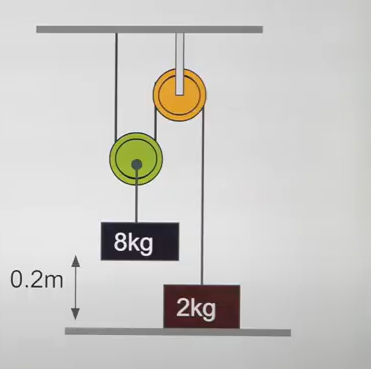Two iron and wooden balls identical in size are released from the same heilght in vacuum. The time taken by them to reach the ground are:
not equal
exactly equal
regularly equal
zero
To solve the problem of the time taken by two identical balls (one made of iron and the other made of wood) to reach the ground when dropped from the same height in a vacuum, we can follow these steps:
1. Understand the Environment:
- The balls are released in a vacuum. This means there is no air resistance acting on the balls. In a vacuum, all objects fall at the same rate regardless of their mass.
2. Identify the Variables:
- Let the height from which the balls are dropped be H.
- The gravitational acceleration is denoted as g.
3. Use the Second Equation of Motion:
- The second equation of motion states:
S=UT+12at2
- Here, S is the distance fallen (which is H), U is the initial velocity (which is 0 since the balls are dropped), a is the acceleration (which is g), and t is the time taken to fall.
4. Substitute the Known Values:
- Since the initial velocity U=0, the equation simplifies to:
H=0⋅T+12gt2
- This simplifies to:
H=12gt2
5. Rearrange to Solve for Time t:
- Rearranging the equation gives:
t2=2Hg
- Taking the square root of both sides, we find:
t=√2Hg
6. Conclusion:
- The time t taken to reach the ground depends only on the height H and the gravitational acceleration g. Since both the iron ball and the wooden ball are dropped from the same height and experience the same gravitational acceleration, they will take the same time to reach the ground.
Final Answer:
The time taken by both the iron and wooden balls to reach the ground is equal.
- The balls are released in a vacuum. This means there is no air resistance acting on the balls. In a vacuum, all objects fall at the same rate regardless of their mass.
- Let the height from which the balls are dropped be H.
- The gravitational acceleration is denoted as g.
- The second equation of motion states:
S=UT+12at2
- Here, S is the distance fallen (which is H), U is the initial velocity (which is 0 since the balls are dropped), a is the acceleration (which is g), and t is the time taken to fall.
- Since the initial velocity U=0, the equation simplifies to:
H=0⋅T+12gt2
- This simplifies to:
H=12gt2
- Rearranging the equation gives:
t2=2Hg
- Taking the square root of both sides, we find:
t=√2Hg
- The time t taken to reach the ground depends only on the height H and the gravitational acceleration g. Since both the iron ball and the wooden ball are dropped from the same height and experience the same gravitational acceleration, they will take the same time to reach the ground.
The time taken by both the iron and wooden balls to reach the ground is equal.
Similar Questions
Knowledge Check
An iron ball and a wooden ball of the same radius are released from a height ‘ h ’ in vacuum. The time taken by both of them to reach the ground is
Aroughly equalBunequalCexactly equalDin the inverse ratio of their diametersAn iron ball and a wooden ball of the same radius are released from the same height in vacuum. They take the same time to reach the ground. The reason for this is
AAcceleration due to gravity in vacuum is same irrespective of the size and mass of the bodyBAcceleration due to gravity in vacuum depends upon the mass of the bodyCThere is no acceleration due to gravity in vacuumDIn vacuum there is a resistance offered to the motion of the body and this resistance depends upon the mass of the bodyAn iron ball and a wooden ball of the same radius are released from a height ‘ h ’ in vacuum. The time taken by both of them to reach the ground is
AunequalBExactly equalCRoughly equalDzero
In the question number 67, the time taken by the ball to reach the ground is
View SolutionAn iron ball and a cork ball of the same radius are released from the same height in vacuum. Both of them reach the ground simultaneously. Which of the following statement is the correct explanation for this?
View SolutionAn iron ball and a wooden ball of the same radius are released from the same height in vacuum. They take the same time to reach the ground. The reason for this is
View SolutionIn a vacuum, a five-rupee coin, a feather of a sparrow bird and a mango are dropped simultaneously from the same height. The time taken by them to reach the bottom it t1,t2andt3 respectively. In this situation, we will observe that
View SolutionA ball is dropped from a 10 m height. How much time, it will take to reach the ground ?
View Solution

